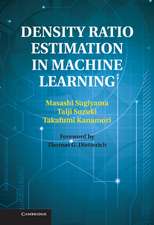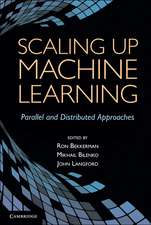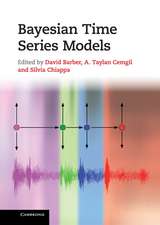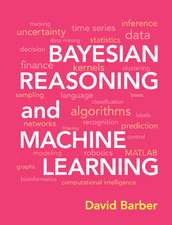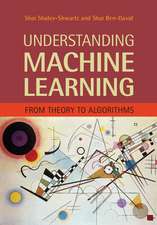Planning Algorithms
Autor Steven M. LaValleen Limba Engleză Hardback – 28 mai 2006
Preț: 728.56 lei
Preț vechi: 910.71 lei
-20% Nou
Puncte Express: 1093
Preț estimativ în valută:
139.42€ • 146.60$ • 115.19£
139.42€ • 146.60$ • 115.19£
Carte tipărită la comandă
Livrare economică 17 aprilie-01 mai
Preluare comenzi: 021 569.72.76
Specificații
ISBN-13: 9780521862059
ISBN-10: 0521862051
Pagini: 844
Ilustrații: 304 exercises
Dimensiuni: 182 x 262 x 43 mm
Greutate: 1.59 kg
Editura: Cambridge University Press
Colecția Cambridge University Press
Locul publicării:New York, United States
ISBN-10: 0521862051
Pagini: 844
Ilustrații: 304 exercises
Dimensiuni: 182 x 262 x 43 mm
Greutate: 1.59 kg
Editura: Cambridge University Press
Colecția Cambridge University Press
Locul publicării:New York, United States
Cuprins
Part I. Introductory Material: 1. Introduction; 2. Discrete planning; Part II. Motion Planning: 3. Geometric representations and transformations; 4. The configuration space; 5. Sampling-based motion planning; 6. Combinatorial motion planning; 7. Extensions of basic motion planning; 8. Feedback motion planning; Part III. Decision-Theoretic Planning: 9. Basic decision theory; 10. Sequential decision theory; 11. Information spaces; 12. Planning under sensing uncertainty; Part IV. Planning Under Differential Constraints: 13. Differential models; 14. Sampling-based planning under differential constraints; 15. System theory and analytical techniques.
Recenzii
'This is a terrific book, a milestone in the robotics literature.' Matt Mason, Director of The Carnegie Mellon Robotics Institute
'Motion planning is an important field of research with applications in such diverse terrains as robotics, molecular modeling, virtual environments, and games. Over the past two decades a huge number of techniques have been developed, all with their merits and shortcomings. The book by Steve LaValle gives an excellent overview of the current state of the art in the field. It should lie on the desk of everybody that is involved in motion planning research or the use of motion planning in applications.' Mark Overmars, Utrecht University
'A great book at the junction where Robotics, Artificial Intelligence, and Control are crossing their paths. For many problems you will find in-depth discussion and algorithms; for virtually all others in the field, an intriguing introduction to make you at ease and entice you to further probing the matter.' Antonio Bicchi, della Università di Pisa
'Since the early 90s, Latombe's book has been the authoritative source for students and researchers working on motion planning problems in robotics. During the succeeding decade and half, the motion planning field moved forward with significant developments. LaValle's book picks up the field where Latombe's book left it, describing in detail major developments such as probabilistic roadmaps, manipulation, and coverage planning. Moreover, the book describes a fundamental generalization of configuration spaces to information spaces. The chapters on information spaces appear here for the first time, making them accessible to students and researchers who wish to tackle progressively more challenging real-world motion planning problems in robotics.' Elon Rimon, Technion
'Planning Algorithms is a daring title. It aims at being ecumenical gathering students and their professors scattered in various departments of Engineering and calling them to share the same mathematical foundations. The story starts with motion planning algorithms. Steve LaValle's deep extensive understanding and his effective expertise in that area are shared in this book. They allow the author to go further and to generalize the famous configuration space of the piano mover problem into the information space. This is the core of the title ambition. All the seminal material born with Robotics, Artificial Intelligence and Control, and developed for more than thirty years in a sparse way, are there uniquely unified. The book is not a catalogue of methods. It is the coherent view of a single researcher. The style is nice making the reading fluent: there is a good balance between informal introduction of concepts and the necessary technical developments. Students, researchers and engineers exploring routes in Artificial Intelligence and Robotics, in Graphics and CAD/CAM, and even Molecular Biology now, will find here amazing computational foundations for their topics.' Jean-Paul Laumond, LAAS-CNRS
' … this book really is monumental and well-written piece of work, and although few will have cause to read more than a fraction of its content, at its price it deserves to find its way onto the bookshelves of many of us, as well as being recommended to our students.' ScienceDirect
'Motion planning is an important field of research with applications in such diverse terrains as robotics, molecular modeling, virtual environments, and games. Over the past two decades a huge number of techniques have been developed, all with their merits and shortcomings. The book by Steve LaValle gives an excellent overview of the current state of the art in the field. It should lie on the desk of everybody that is involved in motion planning research or the use of motion planning in applications.' Mark Overmars, Utrecht University
'A great book at the junction where Robotics, Artificial Intelligence, and Control are crossing their paths. For many problems you will find in-depth discussion and algorithms; for virtually all others in the field, an intriguing introduction to make you at ease and entice you to further probing the matter.' Antonio Bicchi, della Università di Pisa
'Since the early 90s, Latombe's book has been the authoritative source for students and researchers working on motion planning problems in robotics. During the succeeding decade and half, the motion planning field moved forward with significant developments. LaValle's book picks up the field where Latombe's book left it, describing in detail major developments such as probabilistic roadmaps, manipulation, and coverage planning. Moreover, the book describes a fundamental generalization of configuration spaces to information spaces. The chapters on information spaces appear here for the first time, making them accessible to students and researchers who wish to tackle progressively more challenging real-world motion planning problems in robotics.' Elon Rimon, Technion
'Planning Algorithms is a daring title. It aims at being ecumenical gathering students and their professors scattered in various departments of Engineering and calling them to share the same mathematical foundations. The story starts with motion planning algorithms. Steve LaValle's deep extensive understanding and his effective expertise in that area are shared in this book. They allow the author to go further and to generalize the famous configuration space of the piano mover problem into the information space. This is the core of the title ambition. All the seminal material born with Robotics, Artificial Intelligence and Control, and developed for more than thirty years in a sparse way, are there uniquely unified. The book is not a catalogue of methods. It is the coherent view of a single researcher. The style is nice making the reading fluent: there is a good balance between informal introduction of concepts and the necessary technical developments. Students, researchers and engineers exploring routes in Artificial Intelligence and Robotics, in Graphics and CAD/CAM, and even Molecular Biology now, will find here amazing computational foundations for their topics.' Jean-Paul Laumond, LAAS-CNRS
' … this book really is monumental and well-written piece of work, and although few will have cause to read more than a fraction of its content, at its price it deserves to find its way onto the bookshelves of many of us, as well as being recommended to our students.' ScienceDirect
Notă biografică
Descriere
A coherent source for applications including robotics, computational biology, graphics, manufacturing, aerospace applications and medicine.


